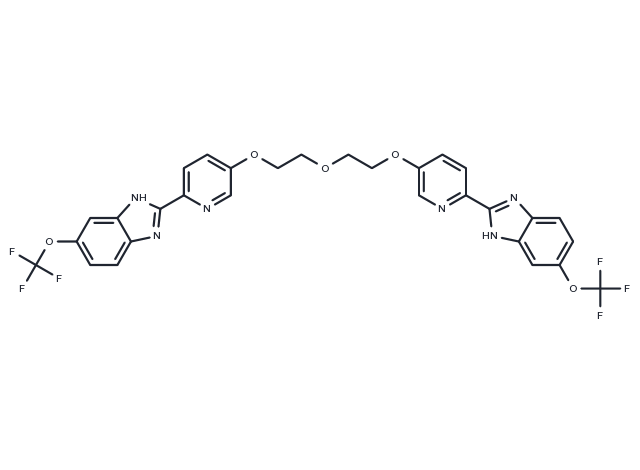Powder: -20°C for 3 years | In solvent: -80°C for 1 year


AI-10-49 is a selective inhibitor of the binding of CBFβ-SMMHC to RUNX1 with IC50 of 260 nM.

| Pack Size | Availability | Price/USD | Quantity |
|---|---|---|---|
| 1 mg | In stock | $ 39.00 | |
| 2 mg | In stock | $ 56.00 | |
| 5 mg | In stock | $ 92.00 | |
| 10 mg | In stock | $ 147.00 | |
| 25 mg | In stock | $ 287.00 | |
| 50 mg | In stock | $ 428.00 | |
| 100 mg | In stock | $ 633.00 | |
| 500 mg | In stock | $ 1,360.00 | |
| 1 mL * 10 mM (in DMSO) | In stock | $ 135.00 |

| Description | AI-10-49 is a selective inhibitor of the binding of CBFβ-SMMHC to RUNX1 with IC50 of 260 nM. |
| Targets&IC50 | CBFβ-SMMHC:260 nM |
| In vitro | AI-10-49 displays specific growth inhibition of inv(16)-positive cell line ME-1. AI-10-49 selectively binds to CBFβ-SMMHC, disrupts its binding to RUNX1, and restores RUNX1 transcriptional activity. [1] |
| In vivo | In mice transplanted with Cbfb+/MYH11;Nras+/G12D leukemic cells, AI-10-49 (200 mg/kg, i.p.) reduces leukemia expansion. [1] |
| Kinase Assay | FRET assays: Cerulean-Runt domain is expressed and purified. Venus-CBFβ-SMMHC is constructed by inserting 6xHis tag and Venus into pET22b vector between NdeI and NcoI sites, and by inserting CBFβ-SMMHC (the CBFβ-SMMHC construct contains 369 amino acids, 1-166 from CBFβ and 166-369 from MYH11 (amino acids 1526-1730)) between the NcoI and BamHI sites. The fusion protein is purified by standard Ni-affinity chromatography with an on column benzonase treatment to remove residual DNA contaminants. Proteins are dialyzed into FRET buffer (25 mM Tris-HCl, pH 7.5, 150 mM KCl, 2 mM MgCl2) prior to use. Protein concentrations are determined by UV absorbance of the Cerulean and Venus at 433 and 513 nm, respectively. Cerulean-Runt domain and Venus-CBFβ-SMMHC were mixed 1:1 to achieve a final concentration of 10 nM in 96 well black COSTAR plates. DMSO solutions of compounds are added to a final DMSO concentration of 5% (v/v) and the plates incubated at room temperature for one hour in the dark. A PHERAstar microplate reader is used to measure fluorescence (excitation at 433 nm and emission measured at 474 and 525 nm). For IC50 determinations, the ratios of the fluorescence intensities at 525 nm and 474 nm are plotted versus the log of compound concentration, and the resulting curve was fit to a sigmoidal curve using Origin7.0. Three independent measurements are performed and their average and deviation are used for IC50 data fitting. |
| Cell Research | Cell lines are cultured in IMDM supplemented with 10%~20% fetal bovine serum (FBS) according to culture conditions indicated by ATCC and 1% penicillin/streptomycin (Pen/Strep). All cell lines are tested for mycoplasma. Cells are cultured at 300,000 cells per ml in 96 well plates for 24 and 48 hours in DMSO, or different of AI-10-47, AI-410-49, AI-4-57, or AI-4-88); each in duplicate or triplicate. Cell viability is evaluated using DAPI by flow cytometry. Data is analyzed using FlowJo software and Graphpad Prism software.(Only for Reference) |
| Molecular Weight | 660.52 |
| Formula | C30H22F6N6O5 |
| CAS No. | 1256094-72-0 |
Powder: -20°C for 3 years | In solvent: -80°C for 1 year
Ethanol: 93 mg/mL (140.8 mM)
DMSO: 93 mg/mL (140.8 mM)
H2O: < 1 mg/mL (insoluble or slightly soluble)
You can also refer to dose conversion for different animals. More
bottom
Please see Inhibitor Handling Instructions for more frequently ask questions. Topics include: how to prepare stock solutions, how to store products, and cautions on cell-based assays & animal experiments, etc.
AI-10-49 1256094-72-0 Cell Cycle/Checkpoint DNA Damage/DNA Repair DNA/RNA Synthesis inhibit AI 10 49 AI1049 Inhibitor inhibitor
